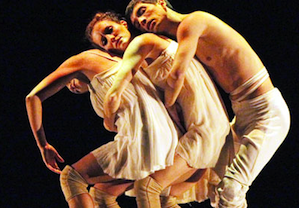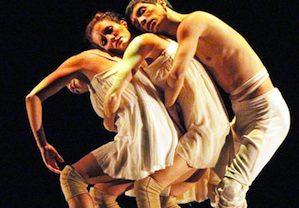
Photo by Marilyn Kingwill
Russell Maliphant Company’s AfterLight, the sole offering on the British troupe’s premiere visit to San Francisco for two performances at the Lam Center, is a one-hour meditation on Vaslav Nijinsky, choreographer, dancer, artist, and tragic figure. Developed after the first section of the piece, a stunning 15-minute solo performed here by Tomasin Gulgec, was nominated for a coveted Olivier Award in 2010, it is as an extended composition lovely to look at, yet ultimately disappointing.
Choreographer Maliphant, who founded his troupe in 1996 and is an artistic associate at Sadler’s Wells, has said that his piece was inspired by Nijinsky’s drawings, which constitute a little-known aspect of his brilliant and tortured career. Their forms, from a cursory glance, are abstract, geometric, and often circular, as AfterLight’s choreographic motifs reflect. None of Nijinsky’s drawings are part of the setting, however.
Maliphant’s own inventiveness with circularity is prodigious. The music is Erik Satie’s Gnossiennes 1-4, played by pianist Dustin Gledhill, along with original music by Andy Cowton. Beneath Michael Hulls’ fascinating shape-shifting lighting, sometimes augmented with blobby abstract projections, the three dancers (Gulgec plus two women, Silvina Cortes and Gemma Nixon) execute, it would seem, every possible manifestation of 360 degrees, and do so compellingly. Partnered and individually, they spin, they swirl. They descend and turn on one knee. They whip around with a leg extended in tendu (they’re barefoot). Their arms rise, fall, loop in circles above their heads. They are superb.
The women wear short pleated tunics suggestive of the garb of Isadora Duncan’s dancers of the early 1900s; Gulgec is in grey pants and a red sweater, which he sometimes removes to dance bare-chested and sometimes ties at his waist, creating a sarong effect that suggests the exoticism of Nijinsky’s roles and performances. But one weakness of the choreography is its complete absence of exoticism, or of any other attitude, for that matter.
There is little to suggest the inventiveness that made what became of Nijinsky such a tragic and compelling tale. All three figures seem abstract and without characterization.
Certainly it would be a mistake (not to mention impossible) to replicate what Nijinsky did; yet because Maliphant has been so clear about the piece as being about Nijinsky, you expect that the acclaimed 15-minute solo with its devastating glimpse of a genius trapped by forces over which he has no control and his descent into madness will be followed by something that, if not narrative, is at least evocative of other aspects of Nijinsky’s work, artistry, conflicts, life.
Clearly Maliphant is intensely concerned about what it takes to make great art and great dance. The performance quality of this brief outing gives hope that he and his company will return soon with much more to say.

